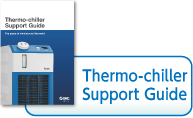Temperature Control Equipment

●Sealing mechanism
The bladed wheel (impeller) in the pump chamber through which the fluid passes is linked to the shaft of the external electric motor, and the rotation of the impeller discharges the fluid. As water or other fluids seeping through the motor shaft and reaching the electric motor can cause short circuits and other damage, it is necessary to have a mechanism sealing the pump chamber off from the shaft. This is known as a “sealing mechanism.”
There are mechanical seal types, magnet coupling types and others.
●SEMI F47
SEMI F47 is a SEMI standard which stipulates guidelines regarding voltage sag immunity.
Semiconductor manufacturers require this standard for temperature control equipment, just like SEMI S2.
●SEMI S2
SEMI is an international industry association of companies producing equipment and materials for the manufacture of semiconductors and flat panel displays. It has established its own standards as safety guidelines for the design of semiconductor manufacturing equipment.
SEMI S2 requirements relate to the work environment, health and safety for products used in semiconductor manufacturing, and cover chemical, radiation, electrical, physical, mechanical, environmental, fire, earthquake, emissions and ergonomics, as well as quality, documentation and manuals etc. Many semiconductor manufacturers require that equipment operating in their plants comply with SEMI S2.
●SEMI S8
SEMI S8 is a guideline on ergonomics which is more detailed than the ergonomic requirements in Section 14 of SEMI S2.
●Signal input/output, I/O
Input/Output signals such as alarm signal, or operation signals. Since there are various communication methods depending on the equipment model, such as relay output and open collector output, communication specifications must be checked before wiring.
●Solenoid valve
A component that switches the flow of fluid from ON to OFF, or changes the direction by moving the plunger (iron core) using the force of electromagnetism.
●Solid state relay (SSR)
A relay which enables switching of high power using low power by using a thyristor or other semiconductor element. In comparison with an electromagnetic relay, this type has no mechanical moving parts, and thus is capable of high-speed switching. SSRs are compact, and have a long service life.
However, this does not mean that contacts are physically isolated. The fact that there is some leakage current even when the device is OFF must be taken into account.
●Specific heat, specific heat capacity
The heat energy required to increase the temperature of an object by a certain temperature interval, under specific pressure and volume conditions.
The specific heat of water: 1 [cal/g·K] = 4.184 x 103 [J/kg·K]
●Specific resistance
A value indicating the electrical insulating properties of a liquid, and the unit used is [Ω·cm]. When expressing the specific resistance of deionized water, it is sometimes called “DI level.”
At 25°C, the specific resistance of theoretically 100% deionized water is 18.3 [MΩ·cm].
●Specified CFC
Due to their stability as a chemical substance and their safety with respect to humans, CFCs came to be widely used as industrial materials, particularly refrigerants. However, it was later recognized that when CFCs (and HCFCs (hydrochlorofluorocarbons)) containing chlorine are released into the atmosphere, they rise up into the ozone layer and deplete it.
This resulted in the establishment of the Montreal Protocol in 1987, which classified CFCs such as Freon R12 and HCFCs such as Freon R22 as “specified CFCs” and prohibited their manufacture. As a result, their use has now almost completely died out.
Instead of specified CFCs and HCFCs, SMC products now use HFC refrigerants such as R134a and R404A that have an ozone depletion potential (ODP) of zero.
●SV
SV: Set Value. In temperature control equipment, this indicates the target value (set value) for performing temperature control.
▲Page Top

















